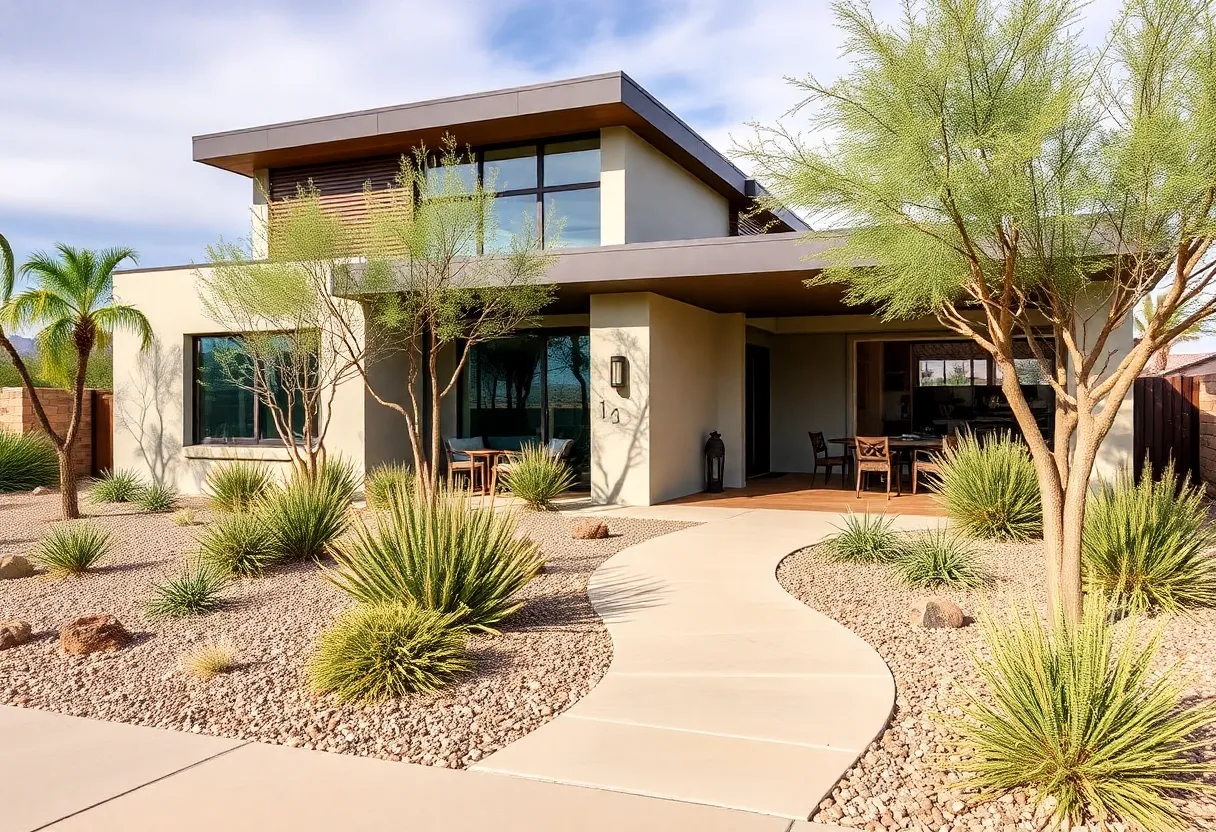How to Navigate Phoenix’s Unique Climate When Building Your New Home: Essential Tips for Homeowners
Climate Overview
Phoenix, located in the Sonoran Desert, experiences an extreme arid climate. Summers often surpass 100°F (38°C), with peak temperatures exceeding 110°F (43°C). Winters are generally mild, making year-round comfort a challenge if homes are not properly designed. Effective planning involves addressing these conditions to ensure both comfort and energy efficiency.
Site Selection and Orientation
Optimal Site Selection
Choosing a site with natural shading features is vital. Opt for locations that provide shade from existing trees or structures to reduce initial heat absorption. Additionally, evaluate flood risk zones, since heavy monsoon rains can occur unexpectedly. Proximity to prevailing winds can be leveraged to enhance natural ventilation, significantly lowering cooling needs.
Strategic Home Orientation
Position the longest sides of your home along the north-south axis. This minimizes exposure to the intense midday and afternoon sun, reducing heat gain. Avoid large, west-facing windows, which receive the most solar radiation during late afternoon hours, increasing cooling demands. Incorporating shading devices such as overhangs or exterior blinds complements this design for further heat reduction.
Building Materials and Insulation
High-Performance Insulation
Proper insulation maintains steady indoor temperatures despite external extremes. Materials like spray foam or cellulose offer high R-values, effectively reducing heat transfer through walls and ceilings. Consider continuous insulation strategies to prevent thermal bridging. Well-insulated walls and roofs decrease the workload on air conditioning systems, resulting in lowered energy consumption.
Reflective Roofing Materials
Opt for roofing options with high solar reflectance. Light-colored shingles or reflective coatings diminish heat absorption, especially crucial in areas with intense sunlight. Attic insulation coupled with reflective roofs ensures cooler attic spaces, preventing heat transfer into living areas. A cool roof can lower indoor temperatures by several degrees, enhancing comfort and reducing cooling costs.
Energy-Efficient Windows
Double or Triple-Paned Windows
Windows are key pathways for heat transfer. Installing double- or triple-glazed units filled with inert gases like argon or krypton reduces thermal conductivity. Low-emissivity (Low-E) coatings further reflect infrared heat, maintaining indoors cooler during peak heat. Proper window placement limits solar gain while maximizing natural light.
UV-Blocking Window Films
Applying UV-blocking films helps shield interiors from sun damage and controls solar heat gain. These films permit ample daylight but prevent excessive heating, creating a more stable indoor environment. They also prolong the lifespan of furnishings by blocking ultraviolet rays.
Efficient HVAC Systems
High SEER Air Conditioning Units
Select air conditioners with a high Seasonal Energy Efficiency Ratio (SEER). An efficient unit can substantially cut energy use while providing effective cooling. Proper sizing according to load calculations prevents undersized units from overworking or oversized units from cycling unnecessarily, both of which reduce efficiency.
Smart Thermostats
Smart thermostats optimize cooling by learning your habits and adjusting temperatures automatically. When programmed, they reduce unnecessary operation during unoccupied periods, leading to significant energy savings. Integration with home automation can also coordinate shading and ventilation systems for maximum efficiency.
Natural Ventilation and Cooling
Design for Cross-Ventilation
Strategically placed windows and vents on opposite sides of rooms facilitate cross-ventilation. When windows are open, cool outdoor air flows through, displacing warmer indoor air. This natural airflow dramatically lowers indoor temperatures without mechanical systems, especially during evenings and mornings when outdoor air is cooler.
Attic Ventilation
Proper attic ventilation prevents heat buildup that can transfer downward. Ridge vents and soffit vents allow hot air to escape, maintaining a cooler roof space. Attic fans can further enhance airflow, improving overall home cooling and prolonging roof lifespan.
Landscaping for Heat Reduction
Strategic Tree Placement
Plant deciduous trees on the south and west sides. Their leaves provide shade during the hottest months and allow sunlight to penetrate in winter, aiding natural heating when needed. Proper tree placement lowers both indoor and outdoor temperatures by blocking direct rays and reducing the heat island effect.
Use of Reflective Materials
Utilize reflective surfaces in driveways, walkways, or pathways. Light-colored or permeable materials reflect rather than absorb heat, minimizing surrounding heat buildup. This approach contributes to cooler outdoor microclimates adjacent to the home.
Water Conservation and Management
Efficient Irrigation Systems
Incorporate drip irrigation for landscape watering. This directs water precisely to plant roots, minimizing evaporation and runoff. Well-designed systems ensure plants remain healthy without overwatering, conserving water and reducing energy associated with water pumping.
Rainwater Harvesting
Implement rainwater collection systems to capture runoff from roofs. Stored rainwater can be used for landscape irrigation, reducing reliance on municipal supplies. This sustainable practice conserves potable water supplies and lowers utility bills.
Smart Home Integration
Automated Shading Systems
Motorized blinds or shades can automatically adjust based on sunlight and temperature sensors. Automated systems respond to external conditions, providing shade during peak heat and maximizing daylight when cooler. This dynamic approach enhances comfort and reduces cooling load.
Energy Monitoring Devices
Installing energy monitors helps track real-time energy consumption. Insight into device usage reveals inefficiencies and areas where automation or adjustments can save energy. Data-driven improvements optimize operational costs and environmental impact.
Regular Maintenance and Upkeep
Roof Inspections
Routine inspections detect damage or wear that compromise thermal performance. Sealing leaks, repairing shingles, and maintaining reflective coatings ensure your roof continues to deflect heat effectively.
HVAC System Maintenance
Keeping filters clean and scheduling professional servicing prolong system life. Well-maintained HVAC units operate efficiently, providing reliable cooling during peak summer months.
Key Features for Building in Phoenix’s Climate
| Feature | Description | Impact on Comfort & Efficiency |
|---|---|---|
| Strategic Orientation | Long sides facing north-south | Reduces heat gain, lowers cooling needs |
| Reflective Roofs | Light-colored and coated surfaces | Minimizes heat absorption, cools interior spaces |
| High-Performance Insulation | Spray foam, cellulose with high R-value | Maintains internal temperature, reduces AC workload |
| Efficient Windows | Double/triple-pane with Low-E coatings | Limits solar gain, improves thermal comfort |
| Natural Ventilation | Cross-ventilation strategies, attic vents | Decreases thermal load naturally |
| Landscaping | Deciduous trees, reflective surfaces | Provides shade, lowers ambient heat |
| Sustainable Water Use | Rainwater harvesting, drip irrigation | Reduces utility costs, conserves water |
| Smart Technology | Automated shading, energy monitors | Optimizes comfort, reduces energy waste |
FAQ
What roofing materials are best suited for Phoenix’s climate?
Light-colored or reflective roofing materials effectively reflect sunlight. Cool roofs prevent excessive heat absorption, contributing to cooler indoor environments and reduced cooling energy.
How can natural ventilation be optimized in a desert climate?
Design homes with cross-ventilation in mind by placing windows and vents on opposite sides. Proper attic ventilation also helps expel hot air, reducing indoor temperatures without mechanical cooling.
Which landscaping choices help keep a home cool?
Plant deciduous trees on the south and west sides for seasonal shading. Use reflective surfaces like light-colored concrete or permeable materials to reduce heat absorption around the property.
What are key strategies for improving energy efficiency in new homes?
Incorporate high-performance insulation, energy-efficient windows, and high-SEER HVAC systems. Smart thermostats and automated shading further optimize energy use and reduce costs.
What maintenance actions are necessary for a cool and efficient home?
Regular roof inspections and HVAC system maintenance ensure ongoing performance. Proper attic ventilation prevents heat buildup, keeping the home cooler longer.
Author: STAFF HERE PHOENIX WRITER
The PHOENIX STAFF WRITER represents the experienced team at HEREPhoenix.com, your go-to source for actionable local news and information in Phoenix, Maricopa County, and beyond. Specializing in "news you can use," we cover essential topics like product reviews for personal and business needs, local business directories, politics, real estate trends, neighborhood insights, and state news affecting the area—with deep expertise drawn from years of dedicated reporting and strong community input, including local press releases and business updates. We deliver top reporting on high-value events such as the Waste Management Phoenix Open, Cactus League Spring Training, and Arizona State Fair. Our coverage extends to key organizations like the Greater Phoenix Chamber of Commerce and Visit Phoenix, plus leading businesses in technology and healthcare that power the local economy such as Intel and Banner Health. As part of the broader HERE network, including HERETucson.com, we provide comprehensive, credible insights into Arizona's dynamic landscape.





